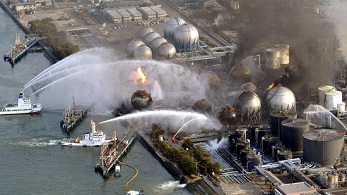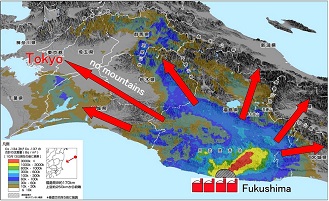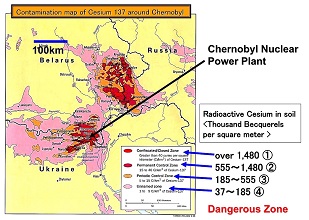Some Facts You Should Know About Fukushima
Paul Craig Roberts/Takashi Hirose
Readers have asked that I write about Fukushima. About all I can tell you with confidence is that we are getting no more truth about Fukushima from the presstitute media than we are about any other subject.
As I understand it, which I hope is incorrectly, Fukushima has the prospect, if the wrong events occur, of essentially eliminating Japan as a country.
Why Japan, the only country to suffer attack by nuclear weapons, made the decision to rely on nuclear plants for its electricity is a mystery. Perhaps the Japanese government was pressured by Washington to accept US nuclear energy technology as a form of tribute payment.
Whether or not Japan under Washington's thumb was a coerced market for Westinghouse, Fukushima is sending radiation into the Pacific Ocean and, apparently, into the groundwater that supplies Tokyo. If the fuel rods that must be removed from a damaged building ignite, calamity will result.
Consider how was it possible for the Japanese, an intelligent people, to locate the Fukushima nuclear energy plants in a tsunami coastal area. This decision shows a lack of any thought whatsoever. Elsewhere nuclear energy plants are located on earthquake faults. Ongoing climate change subjects others to forest fires.
Nuclear energy plants are now sprinkled all over the developed world. Each and every one is subject to accident. An accident, and sustainable life ends for that area of the world. Has human greed for cheap energy destroyed the earth?
Nuclear energy is said to be "clean." But, of course, radiation is not clean, and its death dealing power lasts a very long time. Will shortsighted greed, at the expense of the future, exterminate all life on earth?
No one in the western orbit should expect any answer from the bought-and-paid-for-government.
♣ ♣ ♣
|
Some Facts You Should Know About Fukushima On September 7, 2013 Japan's Prime Minister Shinzo Abe said to the 125th session of the International Olympic Committee, the following:
This will surely be remembered as one of the great lies of modern times. In Japan some people call it the "Ablsolute Lie!" Believing it, the IOC decided to bring the 2020 Olympics to Tokyo. Japanese government spokespersons defend Abe's statement by saying that radiation levels in the Pacific Ocean have not yet exceeded safety standards. This recalls the old story of the man who jumped off a ten-storey building and, as he passed each storey, could be heard saying, "So far, so good." We are talking, remember, about the Pacific Ocean ¨C the greatest body of water on earth, and for all we know, in the universe. Tokyo Electric Power Company ¨C TEPCO ¨C has been pouring water through its melted-down reactor at Fukushima and into the ocean for two and a half years, and so far the Pacific Ocean has been able to dilute that down to below the safety standard. So far so good. But there is no prospect in sight of turning off the water. Here are eight things you need to know. 1. In a residential area park in Tokyo, 230 km from Fukushima, the soil was found to have a radiation level of 92,335 Becquerels per square meter. This is a dangerous level, comparable to what is found around Chernobyl zone (the site of a nuclear catastrophe in 1986). One reason this level of pollution is found in the capital is that between Tokyo and Fukushima there are no mountains high enough to block radioactive clouds. In the capital people who understand the danger absolutely avoid eating food produced in eastern Japan. 2. Inside Fukushima Daiichi Nuclear Reactors #1 ¨C #3 the pipes (which had circulated cooling water) are broken, which caused a meltdown. This means the nuclear fuel overheated, melted, and continued to melt anything it touched. Thus it melted through the bottom of the reactor, and then through the concrete floor of the building, and sank into the ground. As mentioned above, for two and a half years TEPCO workers have been desperately pouring water into the reactor, but it is not known whether the water is actually reaching the melted fuel. If a middle-strength earthquake comes, it is likely to destroy totally the already damaged building. And as a matter of fact, in the last two and a half years earthquakes have continued to hit Fukushima. (And as an additional matter of fact, just as this letter was being written Fukushima was hit by another middle-strength earthquake, but it seems that the building held up one more time. So far so good.) Especially dangerous is Reactor #4, where a large amount of nuclear fuel is being held in a pool, like another disaster waiting for its moment. 3. The cooling water being poured into the reactor is now considered the big problem in Japan. Newspapers and TV stations that previously strove to conceal the danger of nuclear power, are now reporting on this danger every day, and criticizing Shinzo Abe for the lie he told the IOC. The issue is that the highly irradiated water is entering and mixing with the ground water, and this leakage can¡¯t be stopped, so it is spilling into the outer ocean. It is a situation impossible to control. In August, 2013 (the month prior to Abe¡¯s IOC speech) within the site of Fukushima Daiichi Reactor, radiation was measured at 8500 micro Sieverts per hour. That is enough to kill anyone who stayed there for a month. This makes it a very hard place for the workers to get anything done. In Ohkuma-machi, the town where the Daiichi Nuclear Reactor is located, the radiation was measured in July, 2013 (two months before Abe¡¯s talk) at 320 micro Sieverts per hour. This level of radiation would kill a person in two and a half years. Thus, over an area many kilometers wide, ghost towns are increasing. 4. For the sake of the 2020 Tokyo Olympics, an important fact has been left out from reports that go abroad. Only the fact that irradiated water is leaking onto the surface of the ground around the reactor is reported. But deep under the surface the ground water is also being irradiated, and the ground water flows out to sea and mixes with the seawater through sea-bottom springs. It is too late to do anything about this. 5. If you go to the big central fish market near Tokyo and measure the radiation in the air, it registers at about 0.05 micro Sieverts ¨C a little higher than normal level. But if you measure the radiation near the place where the instrument that measures the radiation of the fish is located, the level is two or three times greater (2013 measurement). Vegetables and fish from around the Tokyo area, even if they are irradiated, are not thrown away. This is because the level established by the Japanese Government for permissible radiation in food ¨C which if exceeded the food must not be sold ¨C is the same as the permissible level of radiation in low-level radioactive wastes. Which is to say, in Japan today, as the entire country has been contaminated, we have no choice but to put irradiated garbage on the dinner table. The distribution of irradiated food is also a problem. Food from near Fukushima will be sent to another prefecture, and then sent on, relabeled as produced in the second prefecture. In particular, food distributed by the major food companies, and food served in expensive restaurants, is almost never tested for radiation. 6. In Japan, the only radiation from Fukushima Daiichi Nuclear Reactors that is being measured is the radioactive cesium. However large amounts of strontium 90 and tritium are spreading all over Japan. Strontium and tritium¡¯s radiation consists of beta rays, and are very difficult to measure. However both are extremely dangerous: strontium can cause leukemia, and tritium can cause chromosome disorder. 7. More dangerous still: in order, they say, to get rid of the pollution that has fallen over the wide area of Eastern Japan, they are scraping off the top layer of the soil, and putting it in plastic bags as garbage. Great mountains of these plastic bags, all weather-beaten, are sitting in fields in Eastern Japan subject of course to attack by heavy rain and typhoons. Eventually the plastic will split open and the contents will come spilling out. When that happens, there will be no place left to take them. 8. On 21 September, 2013 (again, as this letter was being composed) the newspaper Tokyo Shimbun reported that Tokyo Governor Naoki Inose said at a press conference that what Abe expressed to the IOC was his intention to get the situation under control. "It is not," Inose said, "under control now." It's a sad story, but this is the present situation of Japan and of Tokyo. I had loved the Japanese food and this land until the Fukushima accident occurred. But now: My best wishes for your health and [a] long life. Takashi Hirose is the author of Fukushima Meltdown: The World's First Earthquake-Tsunami-Nuclear Disaster (2011) available on Amazon both as a Kindle e-book and a Createspace on-demand book. |
Paul Craig Roberts [paulcraigroberts@yahoo.com] was Assistant Secretary of the Treasury during President Reagan’s first term. He was Associate Editor of the Wall Street Journal. He has held numerous academic appointments, including the William E. Simon Chair, Center for Strategic and International Studies, Georgetown University, and Senior Research Fellow, Hoover Institution, Stanford University. He was awarded the Legion of Honor by French President Francois Mitterrand. He is the author of Supply-Side Revolution : An Insider’s Account of Policymaking in Washington; Alienation and the Soviet Economy and Meltdown: Inside the Soviet Economy, and is the co-author with Lawrence M. Stratton of The Tyranny of Good Intentions: How Prosecutors and Bureaucrats Are Trampling the Constitution in the Name of Justice. Click here for Peter Brimelow’s Forbes Magazine interview with Roberts about the recent epidemic of prosecutorial misconduct.
___________________________________________________________________________________
Sources: Paul Craig Roberts' Website + CounterPunch. Photo: EnvironmentCleanGenerations
URL: http://www.a-w-i-p.com/index.php/2013/09/27/some-facts-you-should-know



























